By Lauren Handley, Intern at the Virginia Water Resources Research Center
How often do you think about where your household water comes from, where it goes, or how much of it you use daily? How about whether this water could be recycled to decrease our environmental impacts? Well, did you know that the concept of sustainable wastewater management can do just that? If you would like to know more, keep reading. But first, I encourage you to consider: would you drink wastewater after it was thoroughly treated?
What is it?
Currently, water for wastewater systems is gathered, used, treated, and then discharged. Such a system is successful in providing sanitary water quality; however, it could benefit from a more circular approach, where water is reused or recycled. This is demonstrated by sustainable wastewater management systems, which instead work to reuse and recycle wastewater and reduce consumption. These three concepts are termed the 3R principles and have a goal of improving the relationship between society and the environment (Shanmugam et al. 2022).
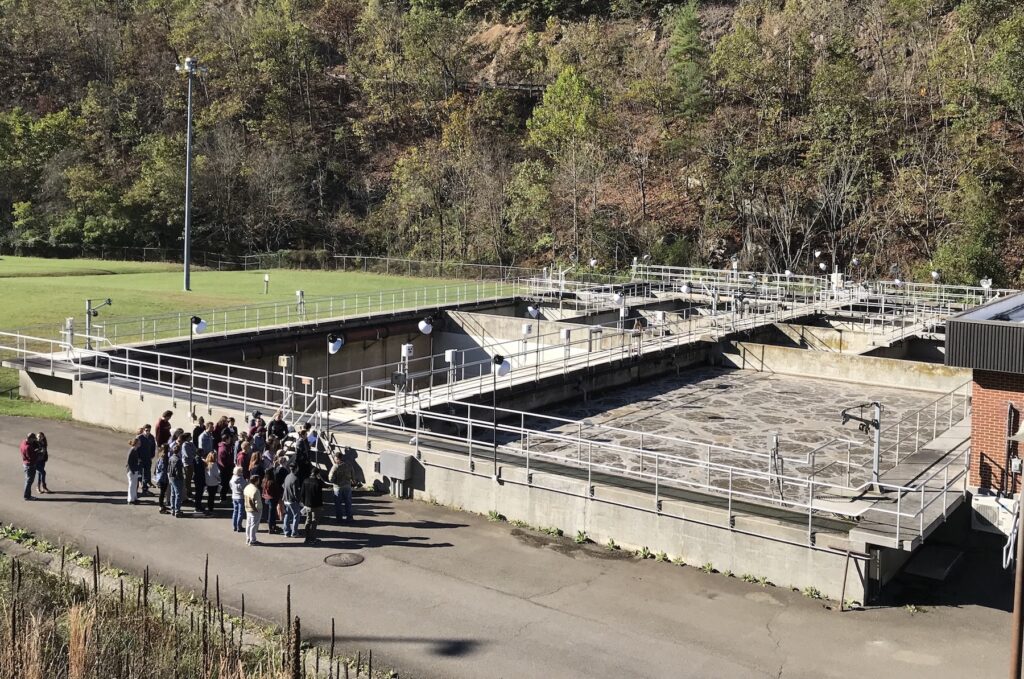
3R Principles
After treatment, wastewater effluent can be reused for various purposes. According to the Safe Water Drinking Act and the Clean Water Act, water intended for reuse must meet its associated water quality standard; therefore, drinking water is held to a higher standard than water used, for example, for road cleaning (EPA 2023). Therefore, in the household, water can be reused for drinking, cooking, showers, toilets, laundry machines, dishwashers, and outdoor use after thorough treatment (Figure 2). Separately, it can be used for industrial production and maintenance, and agricultural irrigation (Figure 2). Finally, the reused wastewater can be put towards community maintenance, such as road cleaning and artificial lakes (EPA 2023).
Human waste, sourced from municipal wastewater, creates an opportunity for recycling. This might seem unsanitary, but the treatment process is extensive, and the produced water or products must meet appropriate standards. Sludge, which is a relatively solid form of wastewater mixed with human waste, can create natural fertilizer for agriculture (Shanmugam et al. 2022) (Figure 2). Secondly, biogas is a term for biofuel gas derived from wastewater during the anaerobic digestion phase of treatment (Periyasamy et al. 2022). Biogas can serve as fuel for electricity, transportation, and cooking (Shanmugam et al. 2022). Therefore, it is a more sustainable replacement for natural gas or other combustion-based energy sources (Periyasamy et al. 2022).
Making the wastewater system circular reduces the need for continuous water extraction, and therefore reduces consumption of natural resources. However, there are more things that can be done. For example, rain barrels harvest stormwater for reuse; this lessens the use of surface and ground water, therefore helping to decrease ecosystem disturbance and over-extracting (Federal Energy Management Program) (Figure 2). Additionally, technology can be adopted, such as low-flow shower heads, toilets, and faucets to reduce overall water usage at the household level. Households can also commit to using less water-intensive settings on appliances and only flushing the toilet when necessary.
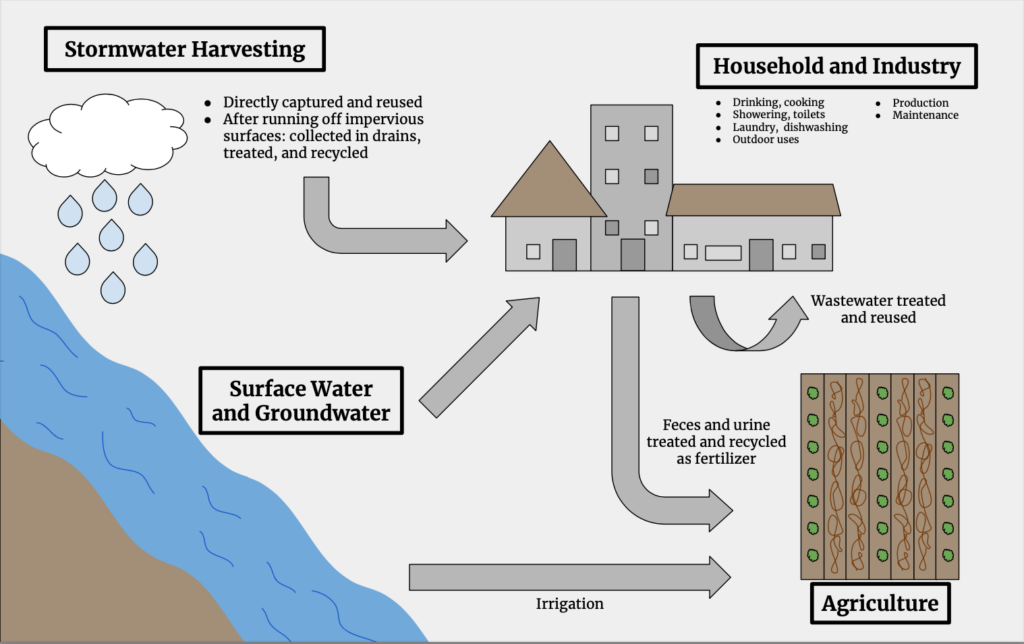
Wastewater Recycling in the US
The Upper Occoquan Service Authority, or the UOSA, provides an example of water reuse local to Virginia and was the first program in the US to augment a reservoir with recycled water (EPA 2015). Specifically, this is in Northern Virginia, near Washington DC, in an area that experienced rapid population growth beginning in the 1970s. As a result, the Occoquan Reservoir, which is the area’s drinking water supply, experienced a decrease in water quality (“Potable Water Reuse at UOSA”). In 1978, this brought forth the idea of treating and reusing water, rather than releasing it back into the watershed. It was supported by the “Occoquan Policy,” a Virginia regulation for regional wastewater treatment plants, and since then it has been very successful and has even grown (“Potable Water Reuse at UOSA”). In addition to wastewater reuse, the UOSA engages in other sustainability initiatives, such as burning biogas, recovering carbon dioxide, and providing biosolids for agricultural fertilizer (“Potable Water Reuse at UOSA”).
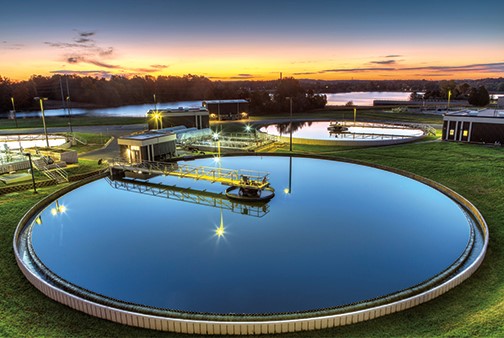
Another example of wastewater reuse is in California. Motivated by drought and climate change, California had been previously recycling water to use for irrigation and groundwater recharge, which are not sources of directly potable water (Hubler 2023). The public’s “ick factor” with drinking water that was previously unsanitary is hard to navigate, so there has been a generalized development of purification and treatment technology (Hubler 2023). The Pure Water Monterey initiation is a great example. Using wastewater, stormwater, food and industry, and impaired surface water, they supply domestic water for Monterey Country and irrigation water for Salinas Valley (Pure Water Monterey).
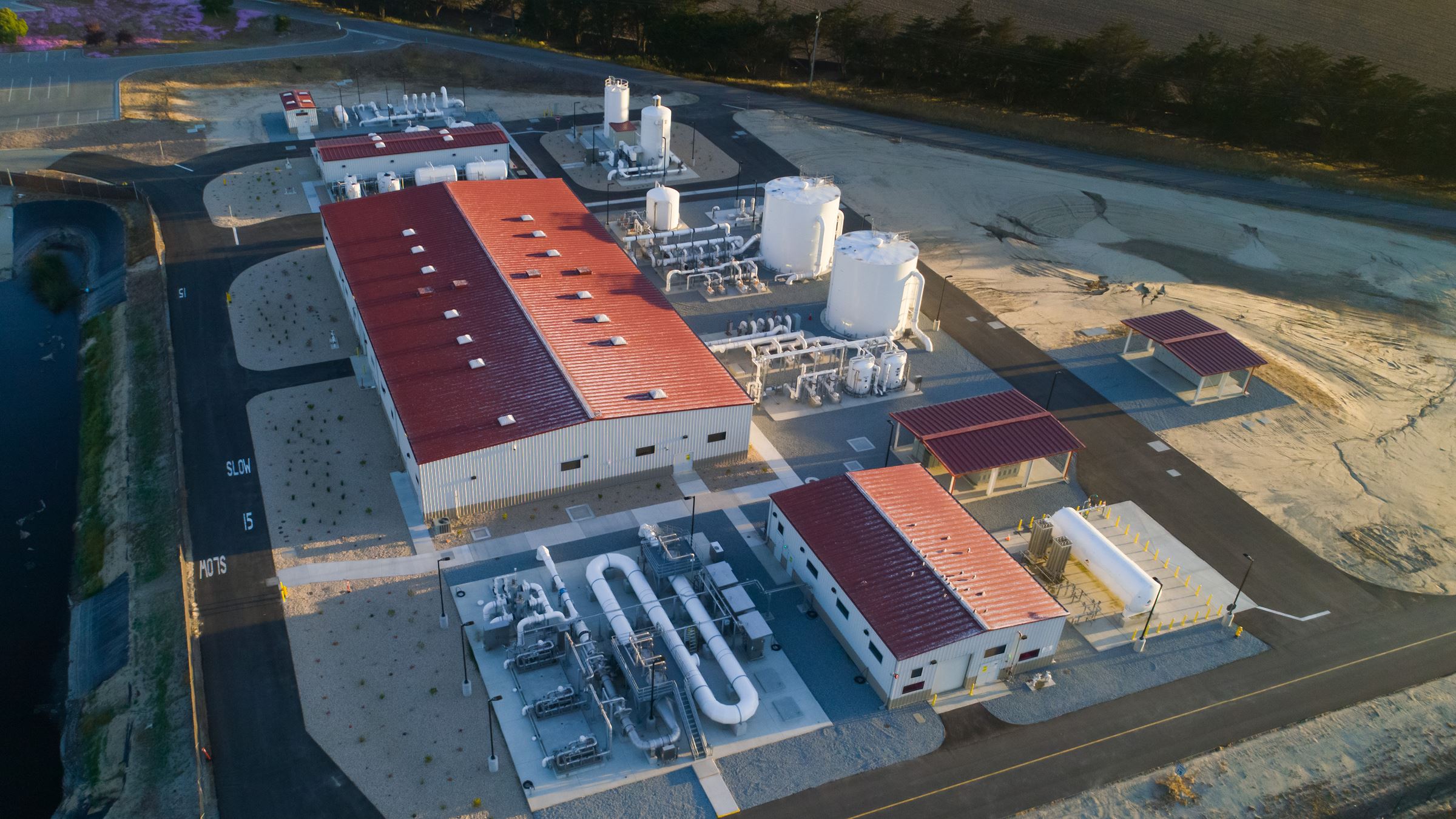
Conducting a Public Survey
To gauge generalized public knowledge and interest on the subject, I sent out a survey through the Virginia Water Resources Research Center’s social media accounts and over email. I received 122 responses: 14% came from those currently receiving or have received an education in Water Resources, 41% from those currently receiving or have received an education generally in STEM, and 45% from those not studying STEM.
56% of the respondents have previously heard of the generalized topic of sustainable wastewater management. As well, 66% of the respondents had heard of the specific ways which water could be recycled.
Next, the participants were given a list of ways that treated wastewater could be reused and asked which ones they would feel comfortable implementing. The answer choices included direct consumption (i.e., drinking and cooking), household uses (e.g., showers, laundry, and toilets), irrigation, and industry and production. Household use, irrigation, and industry and production all received collectively high support at 86%, 86%, and 71% respectively; however, direct consumption received low support (40%) (Figure 5).
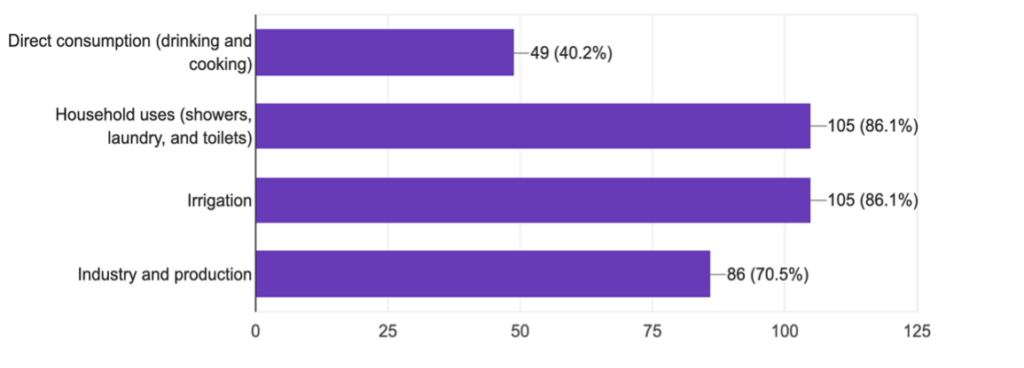
Finally, the participants were given a list of water conservation tactics and asked which ones, if they had to choose, they were most likely to participate in. The options were owning low-flow toilets, shower heads, or faucets (57%); using less water intensive settings on dishwashers or washing machines (71%); and minimizing toilet flushing when it does not entail feces (51%) (Figure 6).
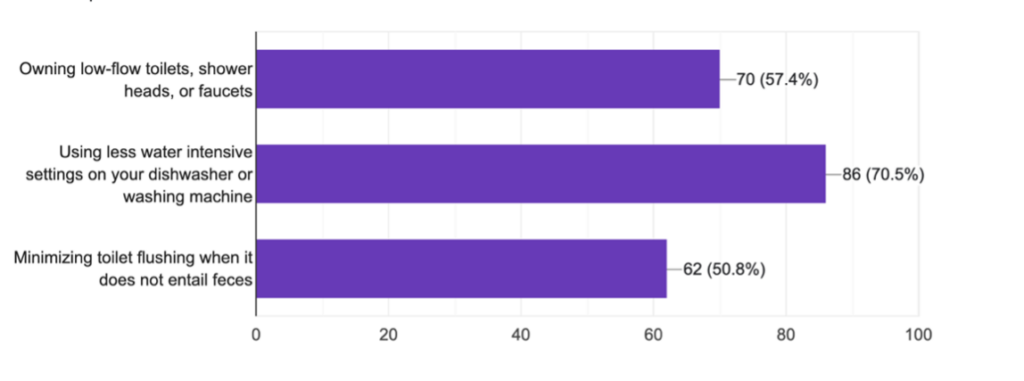
This survey shows how most participants from a range of educational backgrounds have a familiarity with wastewater reuse and generalized willingness to engage in it, except for using recycled wastewater for direct consumption. Therefore, future public education would include the entire process of wastewater recycling; however, education efforts might benefit from highlighting the safety of consuming thoroughly treated wastewater. Another topic of public education, as shown from the survey question about at-home water conservation, might emphasize the benefits of conservation tactics. The significance of education, specifically including public participation, is to stimulate interest and engagement in current society and within future generations (Nourredine et al. 2023).
Conclusion
This circular form of wastewater treatment strives towards sustainability by lessening the effect of human water systems on the environment. In addition to the ecological benefits, a logistical benefit includes how the system can be tailored to the local infrastructure, because the parts are independent of each other and individual adjustments can be made as necessary (Shanmugam et al. 2022) Finally, this system works to lessen human water scarcity issues (Nourredine et al. 2023); specifically, it extends the lifespan of water to increase the quantity of usable water for communities and provide for growing populations (Karn et al. 2023).
However, there are some caveats associated with these sustainable wastewater systems. Existing infrastructure would need to be updated and altered to fit the wastewater reuse system and such projects would require funding. Secondly, public willingness could delay implementation due to a cultural disfavor or perceived lack of sanitation. Public education can play a significant role in remediating this issue.
Ideally, continued discussion will spread knowledge on the topic so as communities transition, they might be more interested in participating in water reuse. Therefore, I would like to encourage you to think back to the questions posed in the beginning. Have any of your answers changed? After hearing about this type of wastewater system, consider again: would you drink wastewater after it was thoroughly treated?
References
EPA. 2015. “Water Reuse Project in VA Providing Multiple Benefits,” https://www.epa.gov/va/water-reuse-project-virginia-providing-multiple-benefits.
EPA. 2023. “Basic Information about Water Reuse.” www.epa.gov/waterreuse/basic-information-about-water-reuse.
Federal Energy Management Program. “Rainwater Harvesting Systems Technology Review.” Energy.Gov. www.energy.gov/femp/rainwater-harvesting-systems-technology-review#:~:text=Rainwater%20harvesting%20captures%2C%20diverts%2C%20and,and%20toilet%20and%20urinal%20flushing.
Hubler, Shawn. 2023. “California Allows Wastewater to Be Recycled Into Drinking Water.” New York Times, December 19, 2023. www.nytimes.com/2023/12/19/us/california-wastewater-drinking-water.html.
Karn, A. L., Pandya, S., Mehbodniya, A., Arslan, F., Sharma, D. K., Phasinam, K., Aftab, M. N., Rajan, R., Bommisetti, R. K., & Sengan, S. 2023. “An integrated approach for sustainable development of wastewater treatment and management system using IoT in smart cities.” Soft Computing – A Fusion of Foundations, Methodologies & Applications 27: 5159–5175. https://doi-org.ezproxy.lib.vt.edu/10.1007/s00500-021-06244-9.
Monterey One Water. “Purification Technology.” www.montereyonewater.org/262/Purification-Technology.
Nourredine, H., Barjenbruch, M., Million, A., El Amrani, B., Chakri, N., & Amraoui, F. 2023. “Linking Urban Water Management, Wastewater Recycling, and Environmental Education: A Case Study on Engaging Youth in Sustainable Water Resource Management in a Public School in Casablanca City, Morocco.” Education Sciences13: 824. https://doi-org.ezproxy.lib.vt.edu/10.3390/educsci13080824.
Periyasamy, S., Temesgen, T., Karthik, V., Isabel, B., Kavitha, S., Banu, R., Sivashanmugam, P. 2022. “Wastewater to Biogas Recovery.” Clean Energy and Resource Recovery, Elsevier. www.sciencedirect.com/science/article/pii/B9780323901789000299.
Pure Water Monterey. “Pure Water Monterey.” Pure Water Monterey | A Groundwater Replenishment Project,purewatermonterey.org/.
Shanmugam, K., Gadhamshetty, V., Tysklind, M., Bhattacharyya, D., & Upadhyayula, V. K. K. 2022. “A sustainable performance assessment framework for circular management of municipal wastewater treatment plants.” Journal of Cleaner Production 339. https://doi-org.ezproxy.lib.vt.edu/10.1016/j.jclepro.2022.130657.
Upper Occoquan Service Authority. “Potable Water Reuse at UOSA.” uosa.org/potable-water-reuse-at-uosa.
Upper Occoquan Service Authority. “UOSA’s Mission and Vision.” https://uosa.org/uosas-mission-and-vision/.
